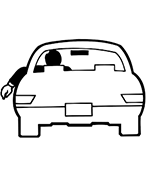[searchform]
Fail to Signal
About
 The driver of a vehicle on a roadway or highway is required to give a signal visible to other drivers on the roadway, when
The driver of a vehicle on a roadway or highway is required to give a signal visible to other drivers on the roadway, when
- turning at an intersection
- into a private drive or roadway
- from one lane of traffic to another
The signal shall be made when any other vehicle may be affected by such a movement.
Mode of Signalling Turn
The signal required shall be given either by a means for a hand or arm signal or by a mechanical or electrical signalling device.
How to signal manually
When the signal is given by means of the hand and arm, the driver or operator shall indicate his or her intention to turn:
- to the left, by extending the hand and arm horizontally and beyond the left side of the vehicle; or
- to the right, by extending the hand and arm upward and beyond the left side of the vehicle
Signal for Stop
The driver of a vehicle upon a highway before stopping or suddenly decreasing the speed of the vehicle if the operation of any other vehicle may be affected by such stopping or decreasing of speed, shall give a signal plainly visible to the driver or operator of the other vehicle.
- manually, by means of the hand and arm extended downward beyond the left side of the vehicle, or
- signalling device, by means of a stop lamp on the rear of the vehicle which shall emit a red or amber light and which shall be actuated upon application for the brake
Insurance Implications
A conviction for failing to signal will affect insurance rates for drivers.
Driving Records and Insurance
Once the driver is convicted of a traffic ticket, the court sends a notice to the Ministry of Transportation.
Upon receiving the record of conviction from the court the Ministry of Transportation then adds the conviction to the driving record.
Driving abstracts are available to anyone who has the drivers licence number for a fee payable to the Ministry of Transportation.
Therefore the way the insurance company will finds out about the ticket is;
- The insurance company contacts
- the Ministry of Transportation and
- checks the drivers abstract, or
- the driver calls and
- tells the insurance company that they received a ticket
Each insurance company is a private company with their own set of rules and standards.
Some insurance companies will not increase insurance rates for one ticket and others will. The problem is drivers don’t know what the insurance company is going to do, and if asked, there is a chance they will increase it due to the inquiry.
Drivers need to keep their driving records clear.
Fines
The out of court fine listed on the traffic ticket for filing to signal is $110.00.
Where the officer issues a summons to appear or the driver disputes the ticket and appears in court the Justice of the Peace (JP) can increase the fine up to $500.00.
The out of court fine is actually, $90.00 but the court adds a $20.00 Victim Fine Surcharge to the ticket.
What is the Victim Fine Surcharge?
- The provincial government adds a victim fine surcharge (VFS) to every non-parking fine imposed under the Provincial Offences Act.
- It is deposited into a special fund to help victims of crime.
- The amount of the VFS is usually 20 per cent of the imposed fine.
- For example, a $100 fine would result in a $20 surcharge.
- Fines over $1,000 carry a surcharge of 25 per cent.
Penalties
Fail to signal tickets have the following penalties:
- out of court fine of $110.00
- maximum fine of $500.00
- 2 demerit points
- conviction appears on driving abstract for 3 years
- can affect insurance rates
Demerit Points
Fail to signal tickets have 2 demerit points.
- G1 drivers are suspended for
- any 4 ticket with 4 demerit points
- accumulating 6 demerit points
- G2 drivers are suspended for
- any 4 ticket with 4 demerit points
- accumulating 6 demerit points
- G drivers are suspended for
- accumulating 15 demerit points
- at 8 points G1 drivers may be required to attend a Demerit Point Interview
Demerit Point Interviews
If you have to attend an interview, you will get a letter (Notice of Interview) to notify you of the time, date and location of the meeting. If you do not attend, your licence could be suspended.
The fee for a demerit point interview is $50 and must be paid in person at any ServiceOntario Centre.
You can pay the fee when you receive the Notice of Interview or within 10 business days of attending the interview.
Failure to pay the interview fee will result in the cancellation of your driver’s licence.
Suspensions
There is no licence suspension for failing give a signal to other drivers.
Default Fine Suspensions
The driver maybe suspended where any fine goes into default. Where the licence is suspended for an unpaid fine, the licence will be suspended until the payment is made to the court.
Demerit Point Suspensions
The accumulation of demerit points can result in a licence suspension.
- Class G1 are suspended for accumulating 6 demerit points
- Class G2 are suspended for accumulating 6 demerit points
- Class G licences receive a drivers licence interview at 8 points
- Class G licences are suspended at 15 demerits
Legal Definition
Signalling turns and stops – Highway Traffic Act 142,1
142 (1) The driver or operator of a vehicle upon a highway before turning to the left or right at any intersection or into a private road or driveway or from one lane for traffic to another lane for traffic or to leave the roadway shall first see that the movement can be made in safety, and if the operation of any other vehicle may be affected by the movement shall give a signal plainly visible to the driver or operator of the other vehicle of the intention to make the movement.
Signal when moving from parked position
(2) The driver or operator of a vehicle parked or stopped on the highway before setting the vehicle in motion shall first see that the movement can be made in safety, and, if in turning the vehicle the operation of any other vehicle may be affected by the movement, shall give a signal plainly visible to the driver or operator of the other vehicle of the intention to make the movement.
Mode of signalling turn
(3) The signal required in subsections (1) and (2) shall be given either by means of the hand and arm in the manner herein specified or by a mechanical or electrical signal device.
How to signal manually
(4) When the signal is given by means of the hand and arm, the driver or operator shall indicate his or her intention to turn,
(a) to the left, by extending the hand and arm horizontally and beyond the left side of the vehicle; or
(b) to the right, by extending the hand and arm upward and beyond the left side of the vehicle.
Idem
(5) Despite clause (4) (b), a person on a bicycle may indicate the intention to turn to the right by extending the right hand and arm horizontally and beyond the right side of the bicycle.
Requirements for signalling device
(6) A mechanical or electrical signal device shall clearly indicate the intention to turn, shall be visible and understandable during day-time and night-time from the front and from the rear of the vehicle for a distance of 30 metres, and shall be self-illuminated when used at any time from one-half hour after sunset to one-half hour before sunrise.
Signalling devices to be used only for purpose of indicating turn
(7) No person while operating or in control of a vehicle upon a highway shall actuate the mechanical or electrical device referred to in subsection (6) for any purpose other than to indicate a movement.
Signal for stop
(8) The driver or operator of a vehicle upon a highway before stopping or suddenly decreasing the speed of the vehicle, if the operation of any other vehicle may be affected by such stopping or decreasing of speed, shall give a signal plainly visible to the driver or operator of the other vehicle of the intention to stop or decrease speed,
- Manually
- (a) by means of the hand and arm extended downward
- beyond the left side of the vehicle; or
- (a) by means of the hand and arm extended downward
- Signalling device
- (b) by means of a stop lamp or lamps on the rear of the vehicle
- which shall emit a red or amber light and
- which shall be actuated upon application of the service or foot brake and
- which may or may not be incorporated with one or more rear lamps
- (b) by means of a stop lamp or lamps on the rear of the vehicle
Case Law
York (Regional Municipality) v. Switzer, 2017 ONCJ 86 (CanLII)
2017-02-10 | 1 page | cited by 1 document
affected — signal a lane change — offence — near-collisions — drivers
[…] [1] This appeal considers whether the offence of failing to signal a lane change contrary to s.142(1) of the Highway Traffic Act RSO 1990 c H8 requires proof that other vehicles had to stop short or were otherwise affected by the failure to signal. […] Section 142(1) HTA […] [2] Section 142(1) requires that a driver signal a lane change if “any other vehicle may be affected by the movement”. […]


